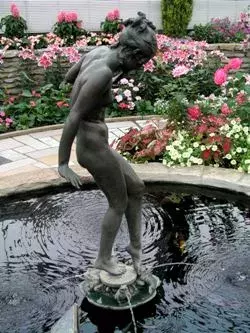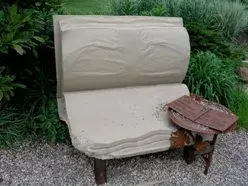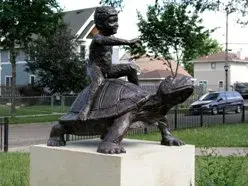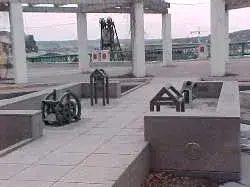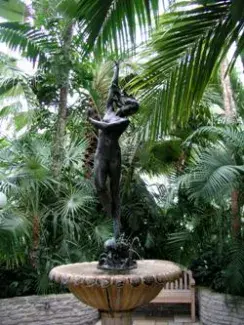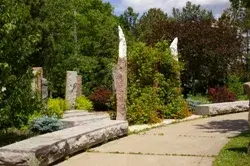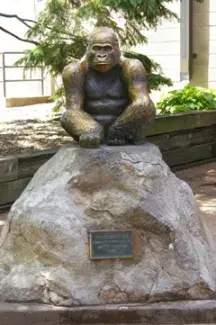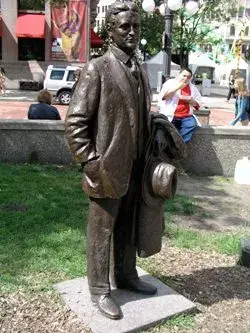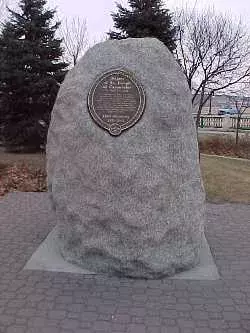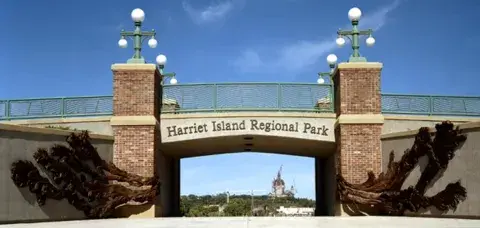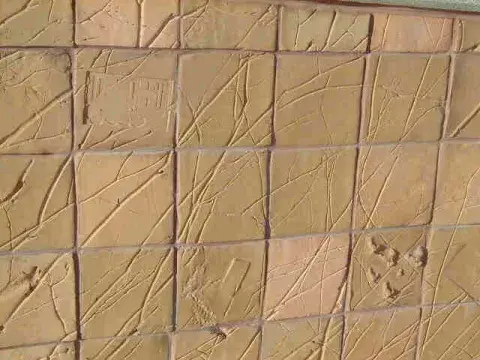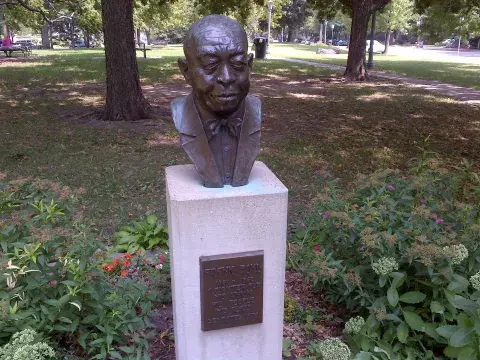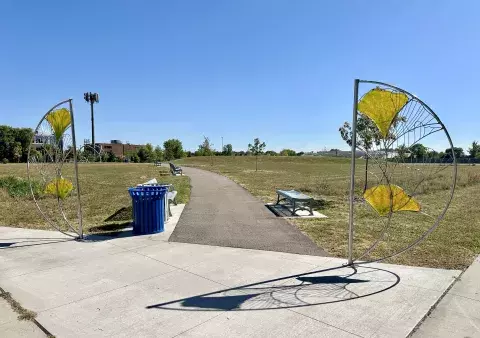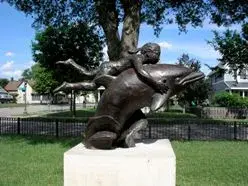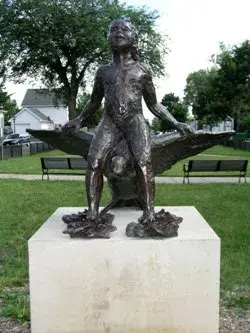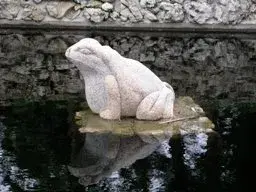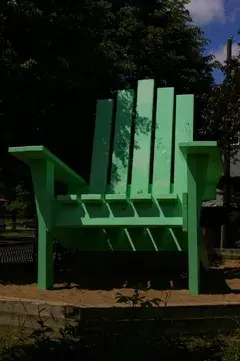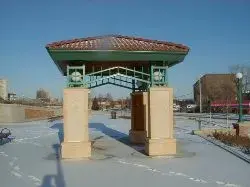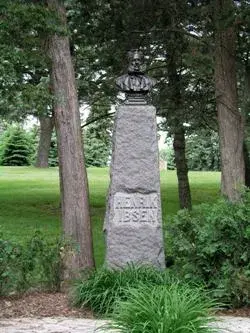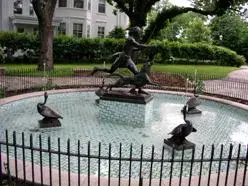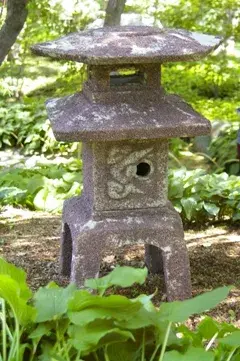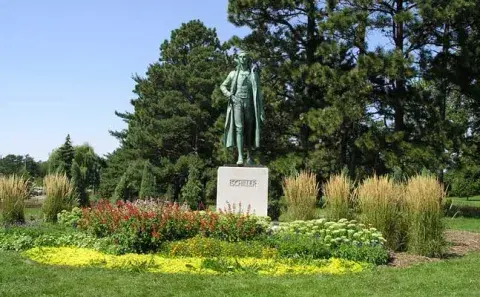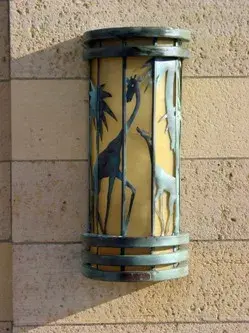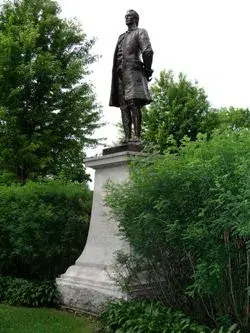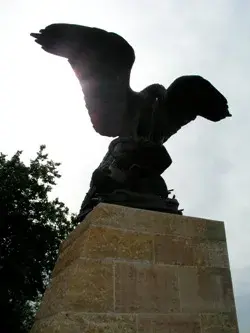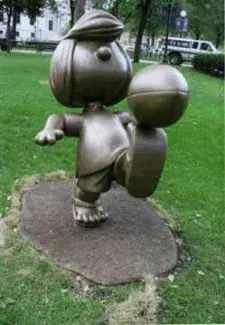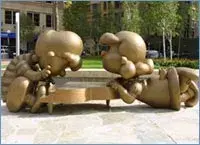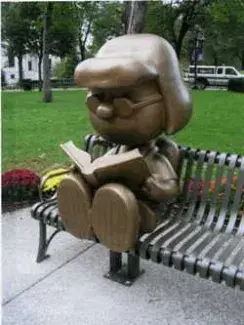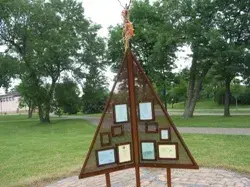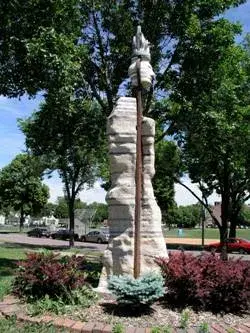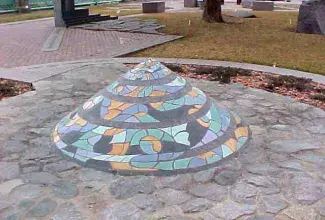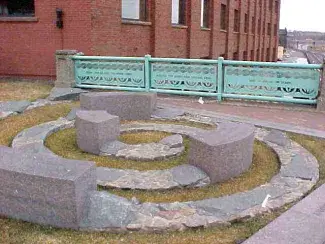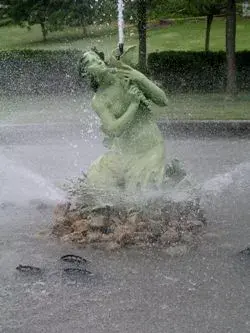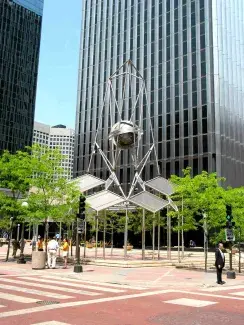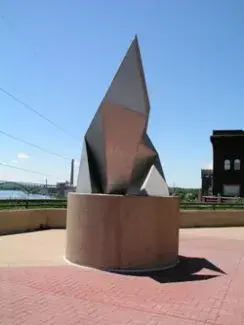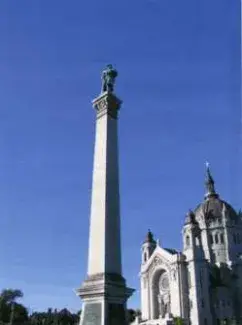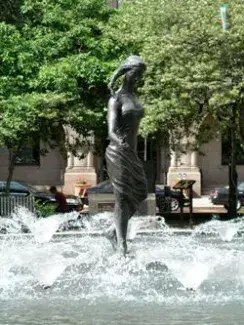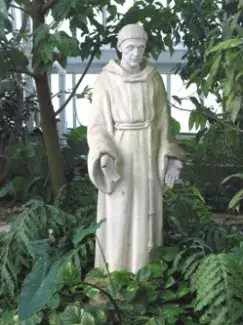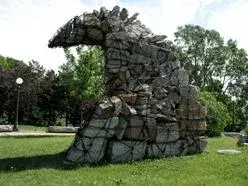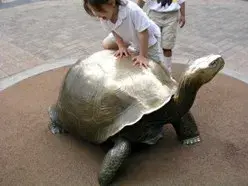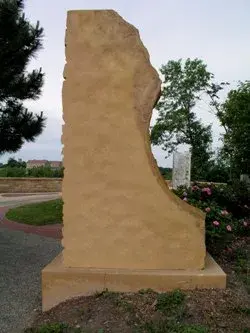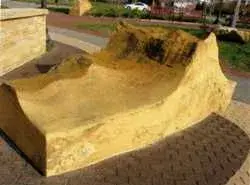Book Benches
Artist Name: Geri Connelly
Media: Cement
Date Created: 1/1/1999
Location: Phalen Poetry Park
History: These benches provide an artistically intriguing resting place. Presently, Connelly works as a staff member at Avalon School. She has also taught art at the University of Minnesota, the Minneapolis Community and Technical College, the Blake School, and the North High School in North St. Paul. She often assists with public art projects.
Boy on Turtle
Artist Name: Nick Legeros
Media: Bronze; Base: sandstone and concrete
Date Created: 1/1/1994
Location: Lyton Park
History: Part of Nick Legeros’s Dreams of our Children series, the Boy on Turtle illustrates a longing to live in harmony with nature. As the sculptor explained, “I wanted to create a work of art with a subject that would have universal appeal as well as be pleasing to the eye. We all have dreams as children and at this tender age did not distinguish those dreams on the basis of race, gender, or economic status. Longing to fly, swim, or ride with creatures of this earth can be interpreted as a desire to live in harmony with nature. I feel we need to express these concepts as an example for our children and a reminder to ourselves.”
Chapel Site Sculpture
Artist Name: Cliff Garten
Media: Brick Plaza, wood and concrete pergola, bronze sculptures, stone plaques lined with trees and grass.
Date Created: 1/1/1991
Location: Kellogg Mall Park
History: Shortly after the establishment of Public Art Saint Paul, Cliff Garten, in collaboration with city landscape architects Tim Agness and Jody Martinez, began re-designing Kellogg Mall Park, originally established in 1931. The sculptures illustrate Father Galtier’s Chapel of 1841, the site upon which Saint Paul was founded, as well as Cass Gilbert’s intended link between the State Capitol and the River along Cedar Street.
Garten received his Master of Fine Arts from the Rhode Island School of Design. He received his Masters of Landscape Architecture from the Harvard University Graduate School of Design, where, among other places, he also worked as a visiting critic.
Crest of the Wave
Artist Name: Harriet W. Frishmuth
Media: Bronze with green patina; Base: bronze fountain with black patina
Date Created: 1/1/1925
Location: Como Park Palm Dome
History: In 1925, Harriet Frishmuth created this bronze sculpture in the Beaux-Arts Style, which is characterized by a lively naturalism reflecting the optimism at the turn of the century. Born in Philadelphia, Pennsylvania in 1880, Frishmuth pursued art in Paris, Berlin, and New York. She began sculpting bookends, ashtrays, and figurines and progressed to larger portraits of female dancers, often as fountains. In 1916, Frishmuth met Desha Delteil, a popular concert dancer, whom she used as a model for many of her most successful sculptures. Because of the Great Depression, she moved from New York back to Philadelphia. She received several awards before she died in 1980, in Connecticut, at the age of ninety-nine. Many consider Crest of the Wave one of Frishmuth's finest achievements.
Czech/Slovak Memorial Gate
Artist Name: Craig David
Media: stone, steel, concrete, garden plants
Date Created: 9/1/2004
Location: North High Bridge Park
History: This sculpture honors the Czech and Slovak immigrants and their families that have lived and worked in the West End of Saint Paul since the 1860s. It incorporates historic salvaged materials including a baptismal gate from Saint Stanislaus Kostka Catholic Church and granite curbstones and pavers from city streets. This piece illustrates several themes. The pylons from granite curb stones and pavers identify the space and the park both as a gateway to the West End and a transition to a better life. The baptismal gate honors the role of the church of Saint Stanislaus Kostka in supporting the community. The figurative representation of the Czech composer Antonin Dvorak’s opera Rusalka and his famous aria “Ode to the Moon” represent the importance of music in the life of Czech and Slovak people. The opera unfolds the tale of Rusalka, the water-nymph, who, under a witch’s spell, tragically leaves her underwater home. This reference to the nocturnal water fairies of Slavonic folklore also refers to the Mississippi, whose overlook this sculpture adorns.
David graduated from the University of Minnesota in 1976, with a Bachelor of Science in Art Education and received from the University of Oregon his Master of Fine Arts in Painting. Presently he creates collaborative environmental site works, drawing on the culture of the people for whom he creates the piece. He lives in the West Side of Saint Paul.
Don the Gorilla
Artist Name: Betty Sievert
Media: Bronze; Base: Stone
Date Created: 1/1/1982
Location: Como Zoo
History: Betty Sievert donated this bronze portrait in memory of Don, a popular gorilla, to the Como Park Zoo in 1982. His statue now provides a popular location for family pictures. Betty Sievert also illustrates children’s books.
F. Scott Fitzgerald
Artist Name: Michael Price
Media: Bronze with warm brown patina on red granite base
Date Created: 1/1/1996
Location: Rice Park
History: Price created this sculpture, representing F. Scott Fitzgerald in his early thirties, to honor the renowned author on the centennial of his birthday. Price said, “I found Fitzgerald to be an honest and generous person, and I wanted to express those qualities in the work.” Price equated his work with the author’s—naturalism, as opposed to realism, characterizes the work of both. “Fitzgerald said he didn't have a large idea, but he had a large perception, and so developed content from the vantage point of immediate human experience. I wanted to emulate that approach,” Price explained, “making this work immediately accessible and engaging.”
Born in 1896, on Cathedral Hill in Saint Paul, Fitzgerald and his family moved to Buffalo, New York, when he was fifteen. Upon returning to Minnesota five years later, he attended the Saint Paul Academy. He entered Princeton University but withdrew before graduation. In 1920, he married Zelda Sayre. During this time, he supported himself by writing a few novels and many short stories. Later, he moved to Hollywood to write scripts for Metro-Goldwyn Mayer. In 1940, Fitzgerald, age forty-four, died in Hollywood.
Father Lucien Galtier Monument
Artist Name: Edwin H. Lundie
Media: 3 Reliefs: Bronze; Base: Boulder
Date Created: 1941
Location: Kellogg Mall Park
History: While transporting the eighteen ton stone to Kellogg Mall Park, the axle of the 3.4 ton truck broke from the weight. However, the memorial finally arrived two days later on June 9, and the city held the dedication the following day.
In 1841, Father Lucien Galtier, a French Catholic missionary, built the Church of Saint Paul on the bank of the Mississippi River. This chapel rested on the site of the present City of Saint Paul, which was named after the chapel. Before this time, the area had been called Pigs Eye after the saloon proprietor Pierre “Pigs Eye” Parrant.
Born in Cedar Rapids, Iowa, in 1886, the architect Edwin H. Lundie moved to Saint Paul in 1904. He designed over three hundred projects in Saint Paul, including residences for many of Saint Paul’s wealthy citizens. He died in 1972, at age eighty-five.
Flood Wave
Artist Name: Ann Klefstad and Jeffrey Kalstrom
Media: Bronze with dark brown, red and green patina; Mounted on concrete walls
Date Created: 6/30/2001
Location: Harriet Island Gateway
History: In 2001, the city commissioned this sculpture when redesigning Harriet Island to be a setting for large events. This sculpture decorates a gateway in the levee system along the Mississippi River.
Klefstad graduated from Saint Olaf College with a triple major in Art, English, and a self-designed major in philosophy and the aesthetics of metaphor. She has received many grants and commissions, producing art not only around the Twin Cities, but also around the nation. She presently writes reviews, editorials, and critiques of contemporary art for mnartist.org and teaches writing at the University of Minnesota, Duluth.
Kalstrom, who hails from Minnesota, works as a metal sculptor.
Floodwaters
Media: Brick tile
Date Created: 6/1/2000
Location: Harriet Island Regional Park
History: In 2001, the city commissioned this sculpture when redesigning Harriet Island to be a setting for large events. This sculpture decorates a gateway in the levee system along the Mississippi River.
Klefstad graduated from Saint Olaf College with a triple major in Art, English, and a self-designed major in philosophy and the aesthetics of metaphor. She has received many grants and commissions, producing art not only around the Twin Cities, but also around the nation. She presently writes reviews, editorials, and critiques of contemporary art for mnartist.org and teaches writing at the University of Minnesota, Duluth.
Kalstrom, who hails from Minnesota, works as a metal sculptor.
Frank Boyd
Artist Name: J. Paul Nesse
Media: Bronze with tan, blue and brown patina; Pedestal: Concrete
Date Created: 5/1/1976
Location: Boyd Park
History: Born in Atchison, Kansas, to a Kentuckian and an African American, Frank Boyd organized the Pullman Porters of St. Paul. In 1926, Boyd became an officer in the Brotherhood of Sleeping Car Porters, Twin Cities Division. Because of his organizing activities, the Pullman Company fired him. He was one of the first two African American electors in the history of the Democratic Party; consequently, in 1944, he attended Franklin D. Roosevelt’s inauguration ceremony as a member of the electoral college.
Born in Montana around 1951, Nesse cultivated an interest in cars early in life. These provided the first models for his sculptures. He worked in a bookstore until the demand for his sculptures increased. Gradually, people began requesting portraits from him, sometimes with a car. Before long, his sculptures produced enough income to sustain him and his family. Presently, Nesse works from his studio near Stillwater, Minnesota while collectors around the world display his pieces.
